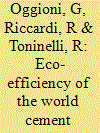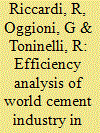| Srl | Item |
| 1 |
ID:
104965


|
|
|
|
|
| Publication |
2011.
|
| Summary/Abstract |
Chemical reactions and the combustion of dirty fuels, such as coal and petroleum coke (petcoke), that are used in cement production processes generate a significant amount of CO2 emissions. In this paper, we provide an eco-efficiency measure for 21 prototypes of cement industries operating in many countries by applying both a data envelopment analysis (DEA) and a directional distance function approach, which are particularly suitable for models where several production inputs and desirable and undesirable outputs are taken into account. To understand whether this eco-efficiency is due to a rational utilization of inputs or to a real carbon dioxide reduction as a consequence of environmental regulation, we analyze the cases where CO2 emissions can either be considered as an input or as an undesirable output. Empirical results show that countries where cement industries invest in technologically advanced kilns and adopt alternative fuels and raw materials in their production processes are eco-efficient. This gives a comparative advantage to emerging countries, such as India and China, which are incentivized to modernize their production processes.
|
|
|
|
|
|
|
|
|
|
|
|
|
|
|
|
| 2 |
ID:
112297


|
|
|
|
|
| Publication |
2012.
|
| Summary/Abstract |
CO2 emissions reduction and energy efficiency improvement are the targets of many environmental policies that aim at tackling climate change. The European Emission Trading is the best example of this engagement against climate change. Considering this framework, this paper studies the efficiency of the high energetic and CO2 emissions intensive cement production process in 21 world countries. Alternative formulations of standard data envelopment analysis models and a directional distance function approach are compared in order to detect the efficiency of the cement sector both in presence and in absence of carbon emissions. We first analyze the entire cement production process and we then concentrate on the production of clinker, a by-product of cement, that is the main responsible of CO2 emissions. Our results show that the inclusion or the exclusion of undesirable factors (CO2) influence efficiency levels as well as the investments in new technologies and the utilization of alternative fuels and raw materials in the cement and clinker production processes.
|
|
|
|
|
|
|
|
|
|
|
|
|
|
|
|